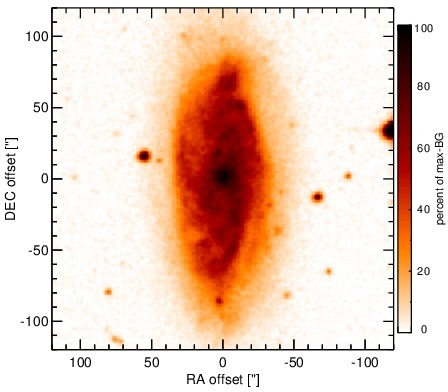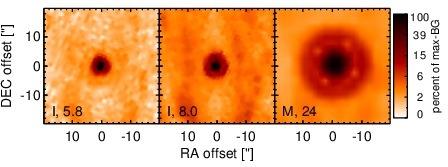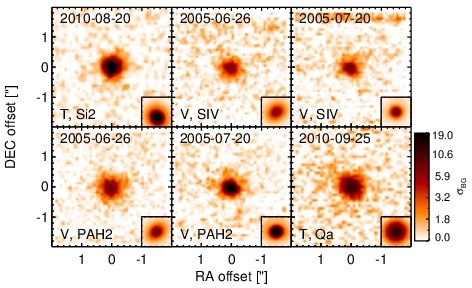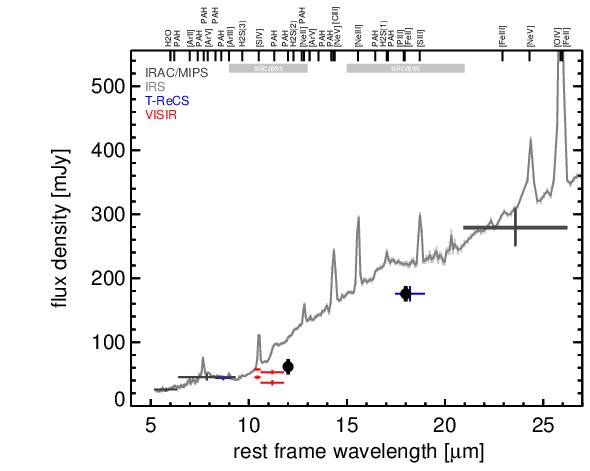Sasmirala Individual Information for NGC 7314
Description
NGC 7314 is an inclined late-type barred spiral galaxy at a distance of D = 18.3 ± 2.1 Mpc (NED redshift-independent median) with a Sy 1.9-2 nucleus with polarized broad emission lines [hughes_atlas_2003, morris_spectrophotometry_1988, lumsden_spectropolarimetry_2004]. It is highly variable in X-rays by up to a factor of four [turner_dramatic_1987] and belongs to the nine-month BAT AGN sample. [morganti_radio_1999] report an unresolved radio core at arcsecond resolution, while [thean_high-resolution_2000] report a double source with ~ 4arcsec ~ 360 pc separation along a PA~ 170∘. After first being detected in the MIR with IRAS, NGC 7314 was followed up with ISO [clavel_2.5-11_2000, ramos_almeida_mid-infrared_2007] and Palomar 5 m/MIRLIN [gorjian_10_2004]. It was also observed with Spitzer/IRAC, IRS and MIPS, and the corresponding IRAC and MIPS images show a compact nucleus surrounded by spiral-like host emission. Our nuclear IRAC 5.8 an 8.0 μm photometry is significantly lower than the values reported in [gallimore_infrared_2010] but in better agreement with the IRS LR staring-mode post-BCD spectrum. The latter exhibits silicate 10 μm absorption, very weak PAH features, prominent forbidden emission lines, and a red spectral slope in νFν-space (see also [shi_9.7_2006, wu_spitzer/irs_2009, tommasin_spitzer-irs_2010, gallimore_infrared_2010, mullaney_defining_2011]). Thus, the arcsecond-scale MIR SED appears to be AGN dominated with only weak star-formation. We observed the nuclear region of NGC 7314 with VISIR in two narrow N-band filters in 2005 (two epochs; [horst_small_2006, horst_mid-infrared_2009]). In addition, T-ReCS imaging in the Si2 and Qa filters from 2010 is available (unpublished, to our knowledge). In all images, a compact nucleus without further host emission was detected. The nucleus appears marginally resolved in all images (FWHM(major axis)~ 0.53arcsec ~ 47pc; PA~ 110∘). The second epoch of VISIR images were taken under better MIR seeing conditions, leading to more reliable estimates for the corresponding unresolved nuclear fluxes. The unresolved nuclear fluxes are on average ~ 32% lower than the Spitzer spectrophotometry with a comparable silicate 10 μm absorption depth, while the total fluxes are consistent with [horst_small_2006].
- [clavel_2.5-11_2000] J. Clavel, B. Schulz, B. Altieri, P. Barr, P. Claes, A. Heras, K. Leech, L. Metcalfe, and A. Salama. 2.5-11 micron spectroscopy and imaging of AGNs. implication for unification schemes . A&A , 357 pp. 839–849, May 2000.
- [gallimore_infrared_2010] J. F. Gallimore, A. Yzaguirre, J. Jakoboski, M. J. Stevenosky, D. J. Axon, S. A. Baum, C. L. Buchanan, M. Elitzur, M. Elvis, C. P. O'Dea, and A. Robinson. Infrared spectral energy distributions of seyfert galaxies: Spitzer space telescope observations of the 12 μm sample of active galaxies . ApJS , 187 pp. 172–211, March 2010.
- [gorjian_10_2004] V. Gorjian, M. W. Werner, T. H. Jarrett, D. M. Cole, and M. E. Ressler. 10 micron imaging of seyfert galaxies from the 12 micron sample . ApJ , 605 pp. 156–167, April 2004.
- [horst_mid-infrared_2009] H. Horst, W. J. Duschl, P. Gandhi, and A. Smette. Mid-infrared imaging of 25 local AGN with VLT-VISIR . A&A , 495 pp. 137–146, February 2009.
- [horst_small_2006] H. Horst, A. Smette, P. Gandhi, and W. J. Duschl. The small dispersion of the mid IR - hard x-ray correlation in active galactic nuclei . A&A , 457 pp. L17–L20, October 2006.
- [hughes_atlas_2003] M. A. Hughes, A. Alonso-Herrero, D. Axon, C. Scarlata, J. Atkinson, D. Batcheldor, J. Binney, A. Capetti, C. M. Carollo, L. Dressel, J. Gerssen, D. Macchetto, W. Maciejewski, A. Marconi, M. Merrifield, M. Ruiz, W. Sparks, M. Stiavelli, Z. Tsvetanov, and R. van der Marel. An atlas of hubble space telescope spectra and images of nearby spiral galaxies . AJ , 126 pp. 742–761, August 2003.
- [lumsden_spectropolarimetry_2004] S. L. Lumsden, D. M. Alexander, and J. H. Hough. Spectropolarimetry of compton-thin seyfert 2 galaxies . MNRAS , 348 pp. 1451–1458, March 2004.
- [morganti_radio_1999] R. Morganti, Z. I. Tsvetanov, J. Gallimore, and M. G. Allen. Radio continuum morphology of southern seyfert galaxies . A&AS , 137 pp. 457–471, June 1999.
- [morris_spectrophotometry_1988] Simon L. Morris and Martin J. Ward. Spectrophotometry of active galaxies. i - the observations . MNRAS , 230 pp. 639–669, February 1988.
- [mullaney_defining_2011] J. R. Mullaney, D. M. Alexander, A. D. Goulding, and R. C. Hickox. Defining the intrinsic AGN infrared spectral energy distribution and measuring its contribution to the infrared output of composite galaxies . MNRAS , page 474, April 2011.
- [ramos_almeida_mid-infrared_2007] C. Ramos Almeida, A. M. Pérez García, J. A. Acosta-Pulido, and J. M. Rodríguez Espinosa. The mid-infrared emission of seyfert galaxies: A new analysis of ISOCAM data . AJ , 134 pp. 2006–2019, November 2007.
- [shi_9.7_2006] Y. Shi, G. H. Rieke, D. C. Hines, V. Gorjian, M. W. Werner, K. Cleary, F. J. Low, P. S. Smith, and J. Bouwman. 9.7 μm silicate features in active galactic nuclei: New insights into unification models . ApJ , 653 pp. 127–136, December 2006.
- [thean_high-resolution_2000] Andy Thean, Alan Pedlar, Marek J. Kukula, Stefi A. Baum, and Christopher P. O'Dea. High-resolution radio observations of seyfert galaxies in the extended 12-μm sample - i. the observations . MNRAS , 314 pp. 573–588, May 2000.
- [tommasin_spitzer-irs_2010] Silvia Tommasin, Luigi Spinoglio, Matthew A. Malkan, and Giovanni Fazio. Spitzer-IRS high-resolution spectroscopy of the 12 μm seyfert galaxies. II. results for the complete data set . ApJ , 709 pp. 1257–1283, February 2010.
- [turner_dramatic_1987] T. J. Turner. Dramatic x-ray variability in the narrow emission line galaxy NGC 7314 . MNRAS , 226 pp. 9P, June 1987.
- [wu_spitzer/irs_2009] Yanling Wu, Vassilis Charmandaris, Jiasheng Huang, Luigi Spinoglio, and Silvia Tommasin. Spitzer/IRS 5-35 μm low-resolution spectroscopy of the 12 μm seyfert sample . ApJ , 701 pp. 658–676, August 2009.
Images

Optical image (DSS, red filter). Displayed are the central 4 arcmin with North being up and East to the left. The colour scaling is linear with white corresponding to the median background (BG) and black to the 0.01% pixels with the highest intensity.

Spitzer MIR images. Displayed are the inner 40 arcsec with North being up and East to the left. The colour scaling is logarithmic with white corresponding to median BG and black to the 0.1% pixels with the highest intensity. The label in the bottom left states instrument and central wavelength of the filter in micron (I: IRAC, M: MIPS).

Subarcsecond-resolution MIR images sorted by increasing filter central wavelength. Displayed are the inner 4 arcsec with North being up and East to the left. The colour scaling is logarithmic with white corresponding to median BG and black to the 75% of the highest intensity of all images in units of sig_bg. The inset image (where present; either bottom or top right) shows the central arcsecond of the PSF from the calibrator star, scaled to match the science target. The labels in the bottom left state instrument and filter names (C: COMICS, M: Michelle, T: T-ReCS, V: VISIR).
SEDs


MIR SED. The description of the symbols in all the SED plots (where present) is the following: Grey crosses and solid lines mark the Spitzer/IRAC, MIPS and IRS data. The colour coding of the other symbols is as follows: green for COMICS, magenta for Michelle, blue for T-ReCS and red for VISIR data. Darker-coloured solid lines mark spectra of the corresponding instrument. The black filled circles mark the nuclear 12 and 18 micron continuum emission estimate from the data (where present). The ticks on the top axis mark positions of common MIR emission lines, while the light grey horizontal bars mark wavelength ranges affected by the silicate 10 and 18 micron features.